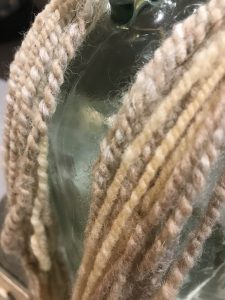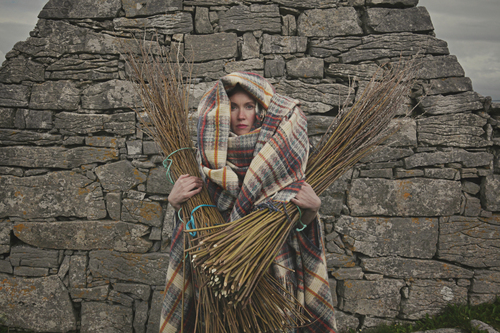This week I was pretty swamped with work for both of the textile classes I was taking, so field study was the main focus while research took a bit of a back seat. I was right in the middle of my wool spinning work for my class at Arbutus (reflection here), and also half way through the beginning weaving course I was taking at the Nifty Knitter (reflection here).
So, crafting took over my life for a bit. It was actually a very relevant experience to have the opportunity to understand just how much time and discipline it requires to complete a piece of work by a specific deadline. As a beginner, my work was definitely completed much slower than someone who has been at it for ages. However, even with that in mind, it gave me a hands on understanding of why cottage industries like khadi cotton and Donegal yarn worked hard to mechanize their products.

I was originally meant to be focusing on dyes this week, but I made the decision to instead focus on crafting. As I’ve continued to study sustainability in the design world, I’ve started to feel as if any dyes at all are a bit unnecessary. Even with plant dyes, the use of fixatives creates waste with undesirable properties. It seems to me a study of dyes and color with a focus on sustainability would take much longer than a week to even begin to have an understanding and I felt that my particular area of study was not heavily dependent on whether or not I explored dyes. So, I decided to focus on things that I had already begun exploring.
One thing I am really excited to have come across is a documentary series called Snáithe (meaning ‘thread’ in the Irish language). The documentary is created and hosted by Ciara O’Doherty, an Irish fashion blogger who is trying to trace the history of Irish textiles and its influence on modern day fashion. What was really striking to me, was that the entire series is narrated in the Irish language – even most of the interviews are conducted in Irish. This is a super incredible connection, because as I have noted earlier, the endurance of the craft traditions of colonized lands seems to be almost inherent with indigenous speech. What is even more interesting, is that the documentary focuses heavily on the story telling ability that Ireland has had throughout history and how weaving and fabric play a role in telling the story of the land. There is something quite chilling to me about the fact that these aspects of Irish textile are being explained in the native tongue; one that dates back to Ireland’s entirely oral, story-telling culture. It is currently being released as a six-part series, so I have only had the opportunity so far to watch the first two that have been released.

With all the excitement about the connections I had been making, I did notice a bit of unbalance in my knowledge of Celtic tradition and Indian tradition – two subjects that I am supposed to be dedicating an equal amount of time to. I think the reasoning behind this is that there is a lot more of a learning curve for me when it comes to Indian culture. There are many different states and languages and cultures within the country, so I am a bit wary of drawing any conclusions in the way that I feel comfortable doing so for Ireland and Scotland. I do, however, wish to broaden my horizons when it comes to an understanding of the culture behind the textiles I am studying. So, I am hoping to dedicate a good portion of Week 8’s research to understand Indian textile culture a bit more.